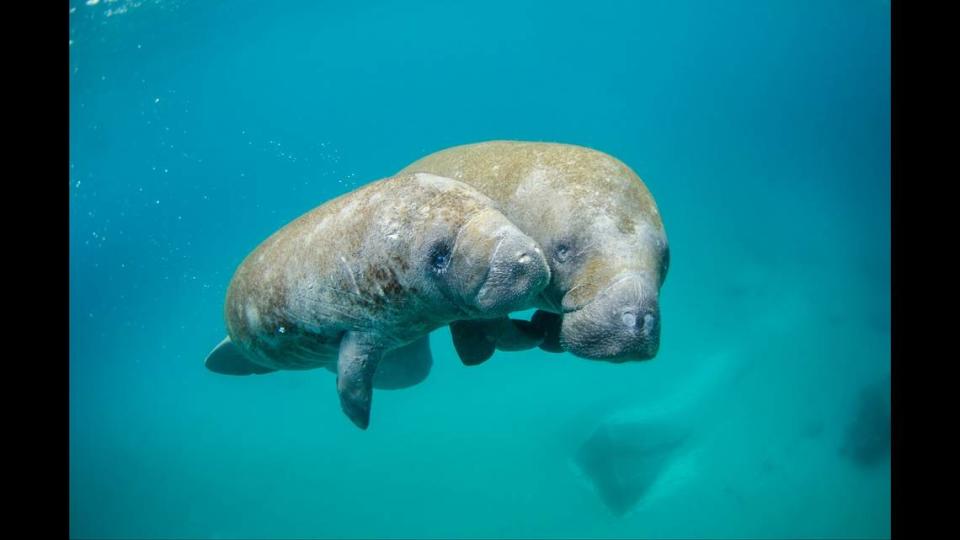Are dolphins bullies? Researchers — and manatees — don’t buy their lovable reputation
Known as one of the most intelligent creatures in the ocean — and the planet — bottlenose dolphins have long built a reputation as an icon of the seas.
Whether showing off their strength by jumping into the air or showing off their personalities by helping stranded swimmers, it seems dolphins can do no wrong — until now.
In a study published in the journal PLOS One on Jan. 10 , researchers question dolphins’ cuddly demeanor after a series of documented attacks on baby manatees in the Caribbean.
Dolphins, a social species, are known to interact with other ocean animals, the researchers said, but interactions between dolphins, part of the cetacean family, and manatees, part of the sirenian family, have rarely been documented.
But the researchers argue confrontations between the two species have been going on for decades — and it’s a one-sided fight.
Beating up baby manatees
Off the shore of Belize and the surrounding islands, baby Antillean manatees, a smaller cousin of the iconic Florida mammal, started appearing separated from their mothers, the study said.
The babies came close to the shore and had scrape marks on their bodies.
The first baby was found in 1999 by a marine mammal researcher when they spotted a group of dolphins surrounding a manatee calf.
“For 15 minutes, the dolphins exhibited a variety of social and affiliative behaviors directed at the manatee calf including rubbing and supportive behaviors, with the dolphins appearing to push the manatee calf to the surface,” the researchers said.
Later that same day, about 3 miles east from where the first calf was spotted, a single dolphin was seen swimming with a baby manatee until they both moved into deeper water.
The baby manatee was alone.
The behavior wasn’t observed again until 2015 when a Belizean resident saw a manatee calf swimming with a dolphin near a boat dock by Belize City, the study said.
“The dolphin was observed investigating the calf with its rostrum,” the front of its head, the study said. “Large splashes and vigorous subsurface movements suggest the dolphin was also harassing the calf.”
Once on the lookout, sightings of these confrontations increased.
In 2018, a group of dolphins approached a mother and calf and tried to separate the two, the researchers said, swimming in between them and lifting the calf in the water.

“Several minutes later, a single dolphin was observed displaying aggression and attacking the calf, ramming the calf out of the water into the mangroves and repeatedly biting it,” the researchers said.
Cases of dolphin aggression towards manatees, particularly calves, were documented several more times until July 2020.
From 2010 to 2020, 13 orphaned manatee babies were found with tooth rake marks on their bodies, suggesting dolphins played a part in their separations from their mothers.
Why does the behavior seem so out of character from the stories of Flipper and Winter we’ve come to know and love?
‘Acting like jerks’
With enough evidence to suggest a larger behavioral trend between dolphins and Antillean manatees in the region, the researchers are struggling to identify the dolphins’ motivation.
“Dolphins do not eat manatees and why they act this way with another species is unclear,” Eric Angel Ramos, the lead author and scientist at the International Foundation for Nature and Sustainability, told Live Science. “It’s likely that they are quite curious when they encounter manatees, and because dolphins are often aggressive with each other, they display this behavior to other species like manatees.”
That is one explanation, but not the only possibility.
“Around the world we see bottlenose dolphins literally acting like jerks and being violent with other species,” senior author Jeremy Kiszka, a biological science professor at Florida International University, told Live Science. “I’m confident in saying that, yeah, I think they want to inflict death.”
The dolphins might also see the manatees “as competitors for food, space or resources,” Kiszka told the outlet, as climate change and human activities cause their habitats to overlap.
Since the interactions were documented over many years, it may be happening more than scientists ever knew, which is concerning for the health of the Antillean manatee population in the Caribbean.
The manatees, a subspecies of the well-known West Indian manatee, can be found anywhere from southeastern Texas to northeastern Brazil, and are listed as endangered on the International Union for Conservation of Nature and Natural Resources Red List.
“Any additional source of mortality is something we should be concerned about,” Kiszka told Live Science.
109 sea turtles found paralyzed on Outer Banks beach in NC. Only 36 survived the day
Baseball legend gives thumbs up to Maryland baby penguin with his name. See chick
Bobcat ‘still at large’ after attack sends 66-year-old to hospital, AZ officials say
Deep-sea creature — with 5 elongated arms — is a ‘beautiful’ new species. See it

